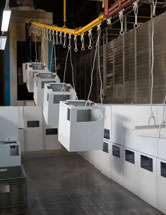
Painting & Plating
 Painting and plating include an array of methods to adhere a coating or finish to a metallic surface to improve either the appearance or functionality of the component. Some of the primary functional benefits to applying this type of surface coating can include increasing corrosion protection, durability, conductivity or shielding.
Painting and plating include an array of methods to adhere a coating or finish to a metallic surface to improve either the appearance or functionality of the component. Some of the primary functional benefits to applying this type of surface coating can include increasing corrosion protection, durability, conductivity or shielding.
Painting industrial parts is not as simple as it may seem. There are many things to consider in addition to color and the overall appearance or branding of your parts. A variety of both wet and dry painting methods are available, such as dip, spray, brush, silk-screen and powder coating. Another important aspect of painting is consideration of the surface preparation and cleaning processes, which are crucial to ensure suitable adhesion. Finally, deciding upon the proper sequence to paint within the overall manufacturing process can affect the final finish of the part.
Plating is a process in which metal is deposited onto a conductive surface. One of the most common types of plating is electroplating, in which a thin layer of materials such as gold, silver, zinc, chrome or nickel are adhered to a part using electrical currents. Vapor, vacuum and sputter deposition methods are also commonly used to plate many metals. Nonmetallic materials such as plastics can also be plated in certain cases using a process called metallizing.
A&T possesses the knowledge and experience to help guide you through the decision-making process to find the appropriate surface coatings and processes to achieve your desired finish. As part of our dedication to providing the highest-quality parts, we can readily provide painting and plating that meets established electrical, medical, military and government specifications and ratings. We offer surface coating of your parts as a turnkey solution and will manage the manufacturing process to keep costs at a minimum.